癌症起源及应对
癌症怎么理解
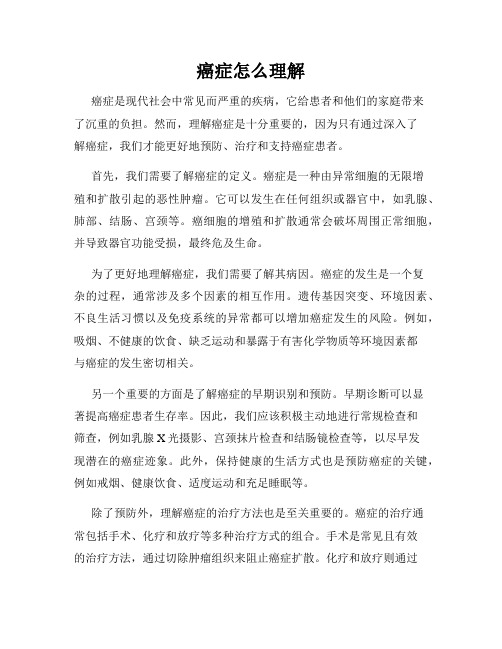
癌症怎么理解癌症是现代社会中常见而严重的疾病,它给患者和他们的家庭带来了沉重的负担。
然而,理解癌症是十分重要的,因为只有通过深入了解癌症,我们才能更好地预防、治疗和支持癌症患者。
首先,我们需要了解癌症的定义。
癌症是一种由异常细胞的无限增殖和扩散引起的恶性肿瘤。
它可以发生在任何组织或器官中,如乳腺、肺部、结肠、宫颈等。
癌细胞的增殖和扩散通常会破坏周围正常细胞,并导致器官功能受损,最终危及生命。
为了更好地理解癌症,我们需要了解其病因。
癌症的发生是一个复杂的过程,通常涉及多个因素的相互作用。
遗传基因突变、环境因素、不良生活习惯以及免疫系统的异常都可以增加癌症发生的风险。
例如,吸烟、不健康的饮食、缺乏运动和暴露于有害化学物质等环境因素都与癌症的发生密切相关。
另一个重要的方面是了解癌症的早期识别和预防。
早期诊断可以显著提高癌症患者生存率。
因此,我们应该积极主动地进行常规检查和筛查,例如乳腺X光摄影、宫颈抹片检查和结肠镜检查等,以尽早发现潜在的癌症迹象。
此外,保持健康的生活方式也是预防癌症的关键,例如戒烟、健康饮食、适度运动和充足睡眠等。
除了预防外,理解癌症的治疗方法也是至关重要的。
癌症的治疗通常包括手术、化疗和放疗等多种治疗方式的组合。
手术是常见且有效的治疗方法,通过切除肿瘤组织来阻止癌症扩散。
化疗和放疗则通过药物和辐射来杀死癌细胞。
此外,靶向治疗和免疫疗法等新兴的治疗手段也显示出潜力。
然而,癌症治疗并非一帆风顺。
治疗期间,患者可能会面临身体上和心理上的许多困难和挑战。
身体上的副作用如恶心、脱发和疲劳等,可能会导致患者的生活质量下降。
心理上,患者往往经历焦虑、抑郁和恐惧等情绪,并需要得到良好的支持和心理援助。
对于癌症患者和他们的家庭来说,理解癌症的社会支持也是非常重要的。
癌症不仅对患者个人的身体健康产生巨大影响,还给整个家庭带来了沉重的负担。
因此,我们应该为癌症患者和他们的家庭提供全面的支持,包括信息资源、心理咨询、社会服务和经济援助等。
什么是癌症?
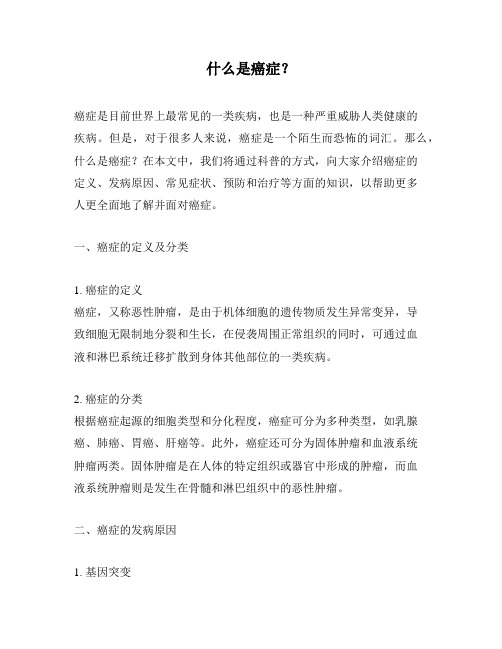
什么是癌症?癌症是目前世界上最常见的一类疾病,也是一种严重威胁人类健康的疾病。
但是,对于很多人来说,癌症是一个陌生而恐怖的词汇。
那么,什么是癌症?在本文中,我们将通过科普的方式,向大家介绍癌症的定义、发病原因、常见症状、预防和治疗等方面的知识,以帮助更多人更全面地了解并面对癌症。
一、癌症的定义及分类1. 癌症的定义癌症,又称恶性肿瘤,是由于机体细胞的遗传物质发生异常变异,导致细胞无限制地分裂和生长,在侵袭周围正常组织的同时,可通过血液和淋巴系统迁移扩散到身体其他部位的一类疾病。
2. 癌症的分类根据癌症起源的细胞类型和分化程度,癌症可分为多种类型,如乳腺癌、肺癌、胃癌、肝癌等。
此外,癌症还可分为固体肿瘤和血液系统肿瘤两类。
固体肿瘤是在人体的特定组织或器官中形成的肿瘤,而血液系统肿瘤则是发生在骨髓和淋巴组织中的恶性肿瘤。
二、癌症的发病原因1. 基因突变癌症的发生往往与细胞基因的突变有关。
基因突变可以是继承的,也可以是后天获得的。
有些遗传突变可以使人从出生时就具有癌症的易感性,而后天获得的突变则与环境因素密切相关。
2. 不良生活习惯吸烟、酗酒、不合理的饮食习惯、缺乏体育运动等不良生活习惯是导致癌症的重要原因之一。
长期的不健康生活方式会增加癌症的发病风险。
三、癌症的常见症状1. 体重下降许多癌症患者在疾病早期会出现不明原因的体重下降。
这主要是由于肿瘤对身体的能量消耗和营养摄取的影响所致。
2. 疲劳无力疲劳感是一种常见的癌症症状,患者常感到长时间的疲劳和无力,甚至在较轻的活动后也会感到极度疲倦。
3. 长期咳嗽某些癌症如肺癌会引起长期的咳嗽,并伴有咳痰、咯血等症状。
如果长期咳嗽不止,应及时就医进行检查。
4. 疼痛不适癌症患者往往会出现持续性或间歇性的疼痛,疼痛部位和程度因癌症类型和进展情况而异。
四、癌症的预防与治疗1. 预防癌症预防癌症的关键在于改变不良生活习惯,如戒烟限酒、保持健康饮食、适度运动等。
此外,对于一些高危人群,如家族有癌症病史的人群,应及早进行相应的筛查。
癌症怎么理解
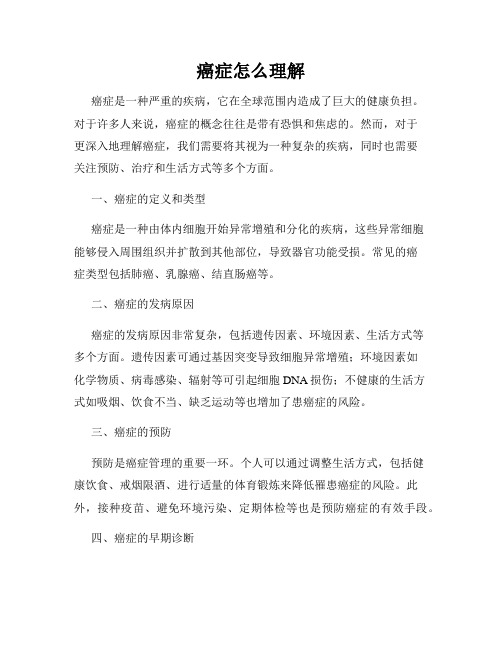
癌症怎么理解癌症是一种严重的疾病,它在全球范围内造成了巨大的健康负担。
对于许多人来说,癌症的概念往往是带有恐惧和焦虑的。
然而,对于更深入地理解癌症,我们需要将其视为一种复杂的疾病,同时也需要关注预防、治疗和生活方式等多个方面。
一、癌症的定义和类型癌症是一种由体内细胞开始异常增殖和分化的疾病,这些异常细胞能够侵入周围组织并扩散到其他部位,导致器官功能受损。
常见的癌症类型包括肺癌、乳腺癌、结直肠癌等。
二、癌症的发病原因癌症的发病原因非常复杂,包括遗传因素、环境因素、生活方式等多个方面。
遗传因素可通过基因突变导致细胞异常增殖;环境因素如化学物质、病毒感染、辐射等可引起细胞DNA损伤;不健康的生活方式如吸烟、饮食不当、缺乏运动等也增加了患癌症的风险。
三、癌症的预防预防是癌症管理的重要一环。
个人可以通过调整生活方式,包括健康饮食、戒烟限酒、进行适量的体育锻炼来降低罹患癌症的风险。
此外,接种疫苗、避免环境污染、定期体检等也是预防癌症的有效手段。
四、癌症的早期诊断癌症的早期诊断对于治疗和预后起着至关重要的作用。
早期癌症往往没有明显的症状,因此定期体检和筛查非常重要。
常见的癌症筛查包括乳腺X线检查、结肠镜检查、肿瘤标志物检测等。
五、癌症的治疗方法癌症的治疗方法多种多样,常见的包括手术切除、放射治疗、化学治疗和靶向治疗等。
治疗方法的选择取决于癌症的类型、分期和患者的身体状况。
个体化治疗在近年来得到了越来越多的关注和应用。
六、癌症的心理支持与康复癌症患者除了需要身体上的治疗外,心理支持和康复也是非常重要的。
癌症患者可能会面临着诸多挑战,包括焦虑、抑郁、身体形象改变等。
提供心理咨询、康复训练、社会支持等都能够帮助患者应对这些困难。
七、癌症的生活方式管理除了正式治疗外,良好的生活方式管理也能够对癌症患者的康复起着积极的促进作用。
适量的运动、均衡的饮食、良好的睡眠和合理的心理应对等都有助于提高患者的生活质量。
结论:了解癌症的定义、类型、预防、早期诊断、治疗方法以及心理支持与康复等方面是理解癌症的基础。
癌症是如何形成的

癌症是如何形成的癌症,作为一种严重威胁人类健康的疾病,常常令人感到恐惧和无助。
了解癌症的形成机制对于预防和治疗癌症至关重要。
本文将从细胞突变、基因突变和肿瘤形成等几个方面来探讨癌症的形成方式。
一、细胞突变细胞是构成我们身体组织的基本单位,而癌症的形成起源于细胞的突变。
细胞突变是指细胞遗传物质DNA发生错误,导致基因的改变。
细胞突变可以由多种原因引起,如暴露于致癌物质、高剂量的辐射以及遗传等。
当细胞突变发生时,正常细胞的生长和死亡机制被破坏,细胞开始无限制地分裂和增殖,最终形成肿瘤。
二、基因突变基因是决定细胞生长和功能的遗传物质,基因突变是癌症形成的一个重要环节。
基因突变可以分为两类:致癌基因(oncogene)突变和抑癌基因(tumor suppressor gene)突变。
致癌基因突变使细胞产生异常的信号传导,促进细胞生长和增殖。
而抑癌基因突变导致抑制细胞分裂和增殖的功能丧失,使细胞无法有效扑灭异常突变细胞。
当致癌基因和抑癌基因同时突变时,细胞的增殖和生长被彻底打乱,肿瘤得以形成。
三、肿瘤形成肿瘤是癌症发展的结果,其形成可以分为两种类型:良性肿瘤和恶性肿瘤。
良性肿瘤生长缓慢,不会侵犯周围组织和器官,通常不会对机体的生命造成威胁。
恶性肿瘤则生长迅速,能侵入周围组织并通过血液或淋巴系统扩散到身体的其他部位,对机体造成巨大的伤害。
肿瘤的形成是一个复杂的过程,包括肿瘤细胞的增殖、血管生成和侵袭性生长。
当正常细胞发生突变并形成肿瘤后,这些肿瘤细胞会通过增殖分裂迅速扩大肿瘤的规模。
同时,肿瘤细胞还能分泌血管生成因子,促进新血管的形成,为肿瘤供给充足的营养物质和氧气。
最后,肿瘤细胞具有侵袭性,能通过血液或淋巴系统转移至身体的其他部位,形成转移性肿瘤。
总结起来,癌症形成源于细胞和基因突变,这些突变破坏了正常细胞的生长和分化机制,导致细胞无限制地分裂和增殖,最终形成肿瘤。
肿瘤的形成是一个复杂的过程,包括肿瘤细胞的增殖、血管生成和侵袭性生长等多个环节。
癌症的产生原因和治疗

癌症的产生原因和治疗癌症是一种常见的疾病,其起因较为复杂,很多人都很好奇到底是什么导致了癌症的发生。
癌症治疗也是需要注意的问题,接下来本文将对此进行阐述。
一、癌症的产生原因1. 环境因素环境因素是癌症的主要诱因之一。
其中最为常见的是空气、水和土壤中的有害物质,如重金属、农药、化学污染物、辐射等等。
长期暴露在这些有害物质中会导致基因突变,最终导致癌症的发生。
2. 遗传因素遗传因素也是导致癌症发生的原因之一。
某些癌症有较高的遗传性。
如果一个人的亲属中有人患有这些癌症,那么他们也极有可能患上同样的癌症。
3. 生活习惯不健康的生活习惯也会增加癌症的风险。
例如,吸烟和大量饮酒都会增加癌症的发病率。
此外,饮食不均衡、缺乏运动等因素也可能会导致肥胖和慢性疾病,从而增加癌症的风险。
二、癌症的治疗1. 手术治疗手术治疗是目前治疗癌症最为有效的方法之一。
它可以从患者身体中切除恶性肿瘤,这对于早期癌症来说尤为重要。
2. 化疗化疗是一种药物治疗方法,可以通过杀死癌细胞的方式来消除癌症。
化疗会使用化学药物,通过静脉注射或口服的方式进入患者体内。
尽管化疗有很多副作用,但它仍然被认为是一种非常有效的癌症治疗方法。
3. 放疗放疗通常被用于治疗恶性肿瘤,这种治疗方法可以使用高强度的辐射来杀死癌细胞。
放疗通常被用于与手术治疗和化疗联合使用。
4. 免疫治疗免疫治疗是最近几年发展起来的一种新型癌症治疗方法。
它可以激发人体免疫系统的自然防御能力,来攻击癌细胞。
这种治疗方法使用免疫细胞、抗体等治疗手段,可以对癌细胞进行攻击和抑制。
结论癌症的预防十分重要,适当的生活习惯以及减少有害物质的暴露都可以有效降低患癌症的风险。
如果已经发现患有癌症,需要选择合适的治疗方法,提高治疗效果,提高患者的生存率。
癌症发生的原因及预防论文
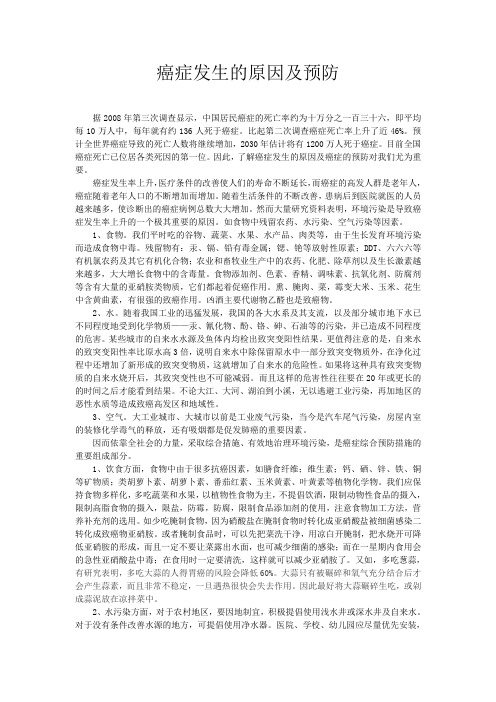
癌症发生的原因及预防据2008年第三次调查显示,中国居民癌症的死亡率约为十万分之一百三十六,即平均每10万人中,每年就有约136人死于癌症。
比起第二次调查癌症死亡率上升了近46%。
预计全世界癌症导致的死亡人数将继续增加,2030年估计将有1200万人死于癌症。
目前全国癌症死亡已位居各类死因的第一位。
因此,了解癌症发生的原因及癌症的预防对我们尤为重要。
癌症发生率上升,医疗条件的改善使人们的寿命不断延长,而癌症的高发人群是老年人,癌症随着老年人口的不断增加而增加。
随着生活条件的不断改善,患病后到医院就医的人员越来越多,使诊断出的癌症病例总数大大增加。
然而大量研究资料表明,环境污染是导致癌症发生率上升的一个极其重要的原因。
如食物中残留农药、水污染、空气污染等因素。
1、食物。
我们平时吃的谷物、蔬菜、水果、水产品、肉类等,由于生长发育环境污染而造成食物中毒。
残留物有:汞、镉、铅有毒金属;锶、铯等放射性原素;DDT、六六六等有机氯农药及其它有机化合物;农业和畜牧业生产中的农药、化肥、除草剂以及生长激素越来越多,大大增长食物中的含毒量。
食物添加剂、色素、香精、调味素、抗氧化剂、防腐剂等含有大量的亚硝胺类物质,它们都起着促癌作用。
熏、腌肉、菜,霉变大米、玉米、花生中含黄曲素,有很强的致癌作用。
凶酒主要代谢物乙醛也是致癌物。
2、水。
随着我国工业的迅猛发展,我国的各大水系及其支流,以及部分城市地下水已不同程度地受到化学物质——汞、氰化物、酚、铬、砷、石油等的污染,并已造成不同程度的危害。
某些城市的自来水水源及鱼体内均检出致突变阳性结果。
更值得注意的是,自来水的致突变阳性率比原水高3倍,说明自来水中除保留原水中一部分致突变物质外,在净化过程中还增加了新形成的致突变物质,这就增加了自来水的危险性。
如果将这种具有致突变物质的自来水烧开后,其致突变性也不可能减弱。
而且这样的危害性往往要在20年或更长的的时间之后才能看到结果。
癌症的发病因素与治疗方法分析
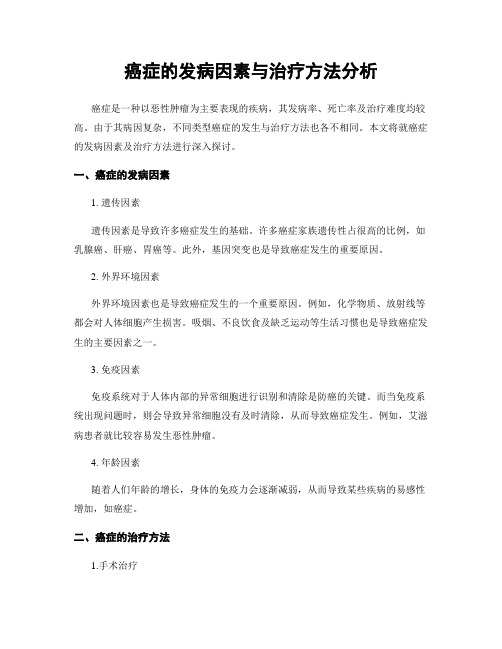
癌症的发病因素与治疗方法分析癌症是一种以恶性肿瘤为主要表现的疾病,其发病率、死亡率及治疗难度均较高。
由于其病因复杂,不同类型癌症的发生与治疗方法也各不相同。
本文将就癌症的发病因素及治疗方法进行深入探讨。
一、癌症的发病因素1. 遗传因素遗传因素是导致许多癌症发生的基础。
许多癌症家族遗传性占很高的比例,如乳腺癌、肝癌、胃癌等。
此外,基因突变也是导致癌症发生的重要原因。
2. 外界环境因素外界环境因素也是导致癌症发生的一个重要原因。
例如,化学物质、放射线等都会对人体细胞产生损害。
吸烟、不良饮食及缺乏运动等生活习惯也是导致癌症发生的主要因素之一。
3. 免疫因素免疫系统对于人体内部的异常细胞进行识别和清除是防癌的关键。
而当免疫系统出现问题时,则会导致异常细胞没有及时清除,从而导致癌症发生。
例如,艾滋病患者就比较容易发生恶性肿瘤。
4. 年龄因素随着人们年龄的增长,身体的免疫力会逐渐减弱,从而导致某些疾病的易感性增加,如癌症。
二、癌症的治疗方法1.手术治疗手术治疗在癌症治疗中占有重要的位置,它通过手术切除肿瘤组织来达到治疗癌症的目的。
然而,手术需要对患者身体进行切割,可能会造成许多不良后果。
基于这种情况,手术治疗对于某些患者来说并不可取。
2. 化疗化疗是在全身使用化学药物来杀死癌细胞。
由于化学药物可以在全身各个部位到达,所以化疗能够有效地对体内的癌细胞进行清除。
但是,由于化疗药物具有毒性和副作用,所以很多患者在接受化疗的过程中会出现恶心、呕吐、头发脱落等症状。
3. 放疗放疗是通过使用高能量的辐射来杀死癌细胞。
相比于化疗,放疗的副作用要小。
尽管如此,放疗仍然可能对患者的身体造成损害,如对皮肤和其他身体组织产生辐射性损伤等。
4. 免疫治疗免疫治疗是近年来研究的一种新型癌症治疗方法。
它利用人体自身的免疫系统来识别并清除癌细胞。
免疫治疗对患者身体的影响相对较小,但由于癌症的免疫逃逸机制,免疫治疗仍然存在不少挑战。
总的来说,为了使癌症患者获得最佳的治疗效果,应当选择合适的治疗方法,以及采取标准的治疗方案。
关于癌症科普演讲稿

关于癌症科普演讲稿随着人们生活水平的提高,癌症已经成为了严峻的全球性问题。
癌症是指机体某些组织细胞异常增生而形成的肿瘤,出现癌症时,患者不仅要面临着身体上的折磨,还需要面对巨大的心理压力和经济负担。
因此,提高大众对癌症的认识和了解,就成为了当前必须重视解决的难题。
下面,我们就来详细了解一下癌症的相关知识。
一、癌症的概念癌症是一种以体细胞异常增生为主要特征,以侵袭、转移、危及生命为严重后果的一类常见病。
癌症的症状多种多样,不同的癌症有着不同的症状,早期往往没有明显的表现,而较为明显的症状可能已经是癌症晚期了。
二、癌症的成因关于癌症的成因,有很多的研究数据需要依据不同的病种进行分析。
总体来说,癌症是由于在经过了细胞基因突变后,致使细胞的正常分裂被打乱从而进一步诱导癌变。
目前普遍的认为是癌症发生的原因主要分为以下几种:(1)普通体细胞的基因突变:癌症发生的主要原因就是因为体内存储的DNA 发生突变,导致癌细胞的生长过程变得异常,从而产生恶性肿瘤。
(2)病毒感染:某些病毒可以引起人体细胞的基因突变,其中腺病毒、人乳头瘤病毒等与某些癌症的病因机制有关。
比如,人乳头瘤病毒是导致宫颈癌的主要因素之一。
(3)环境因素:大量的研究数据表明,环境中存在许多危害因素,如放射线、化学物质、致癌干扰素等,都可能导致癌症的发生。
三、如何预防癌症预防癌症既要遵循科学的方法,又要通过日常生活和饮食习惯来达到良好的健康实践。
具体来说有以下内容:(1)坚持做全身体检:定期到医院做全身体检,这有利于早期发现癌症,从而及时采取处理措施。
在40岁之前应该做一次全身体检,40岁以上因人而异。
(2)避免过度曝露于各种危险因素:坚决拒绝吸烟、酗酒、过度工作和不健康的生活方式,同时要少接触食品添加剂,避免与有害物质接触。
(3)保持良好的饮食和生活习惯:布置废品、环保易拉罐等垃圾时,务必做好分类。
此外,多食用蔬菜、水果、杂粮及动物性食品等可以增强肝脏的功能,从而减少肝癌等癌症的发生。
癌症的原理和作用机制

癌症的原理和作用机制癌症,作为一种严重威胁人类健康的疾病,在全球范围内都备受关注。
了解癌症的原理和作用机制,对于预防、诊断和治疗癌症具有重要意义。
本文将探讨癌症的起源、发展以及相关机制,以期为深入研究和应对癌症提供参考。
一、癌症的起源癌症是由细胞发生异常增殖并失控形成肿瘤的疾病。
正常情况下,细胞的生长和分裂是受到机体内部一系列严格调控的,确保细胞的功能正常并维持组织有序。
然而,在某些情况下,细胞的遗传物质DNA 发生突变或损伤,导致细胞的生长和分裂能力失控,从而形成肿瘤。
癌症的起源有多种因素,包括遗传因素、环境因素和生活方式等。
遗传因素是指某些人具有一些与遗传相关的突变或突变易感基因,使其更容易发展为癌症。
例如,BRCA1和BRCA2基因突变与乳腺癌和卵巢癌的发生风险增加有关。
环境因素主要是指外界环境中存在的致癌物质,如化学物质、病毒感染、放射线等。
生活方式因素包括不健康的饮食、缺乏锻炼、吸烟和酗酒等,这些因素与癌症的发病率显著相关。
二、癌症的发展过程癌症发展是一个复杂的过程,通常包括以下几个阶段:癌前病变、原位癌、浸润癌和转移癌。
1. 癌前病变阶段:癌前病变是指一些异常的细胞增生,但尚未具备恶性肿瘤的特点。
这些细胞在形态上可能有一些异常变化,但尚未具备侵袭和扩散的能力。
2. 原位癌阶段:原位癌是指肿瘤细胞仅限于原发部位,并未侵犯邻近组织和器官。
这个阶段的肿瘤虽然未扩散,但存在潜在的恶性转化可能。
3. 浸润癌阶段:浸润癌是指肿瘤细胞开始侵犯并入侵邻近组织和器官。
在这一阶段,癌细胞能够通过血液循环和淋巴系统扩散至其他部位。
4. 转移癌阶段:转移癌是指肿瘤细胞进一步扩散到远处器官和组织的阶段。
这是癌症最危险的阶段,也是最难以治愈的阶段。
三、癌症作用机制癌症的发展过程与一系列的作用机制密切相关。
以下是一些常见的癌症作用机制:1. 基因突变:基因突变是导致癌症的主要原因之一。
这些突变可以由诸如化学物质暴露、紫外线照射和病毒感染等外部因素引起,也可以由内部因素如DNA复制错误引起。
癌症的综合防治策略

环境因素改善策略
01
02
03
减少环境污染
加强环境治理,减少空气 、水源、土壤等环境污染 ,降低环境致癌物的暴露 水平。
避免职业暴露
对于存在职业暴露风险的 人群,应采取有效的防护 措施,如佩戴防护用品、 改善作业环境等。
倡导绿色生活
推广节能环保的生活方式 ,减少使用一次性塑料制 品,鼓励使用环保材料。
推动志愿服务
招募和培训志愿者,为癌症患者提供心理支持、康复指导 等服务。
国际合作交流平台搭建
加强与国际组织合作
参与世界卫生组织、国际癌症研究机构等国际组织的合作 项目。
引进先进技术和管理经验
学习借鉴国际先进的癌症诊疗技术和管理经验,提升国内 防治水平。
推动国际工作。
疗安全。
靶向药物和免疫治疗进展介绍
靶向药物
针对特定基因突变或蛋 白表达的肿瘤,使用相 应的靶向药物进行治疗 ,如EGFR抑制剂、 HER2抗体等。
免疫治疗
利用患者自身的免疫系 统来攻击肿瘤细胞,包 括免疫检查点抑制剂、 CAR-T细胞疗法等新型 免疫治疗方法。
临床试验及研究
关注最新的靶向药物和 免疫治疗临床试验及研 究成果,为患者提供更 多治疗选择。
03
诊断方法与技术创新
影像学检查进展及应用
计算机断层扫描(CT)
提供高分辨率的断层图像,有助于发现早期肿瘤和评估肿瘤扩散情况 。
磁共振成像(MRI)
利用磁场和射频脉冲生成图像,对软组织分辨率高,特别适用于脑部 和腹部肿瘤的诊断。
超声成像
利用声波反射原理生成图像,实时、无创且价格较低,广泛用于乳腺 、甲状腺等浅表器官的检查。
癌症其实是一种自生的求生机制癌症不是病

癌症其实是一种自生的求生机制癌症不是病癌症其实是一种自生的求生机制癌症不是病当我们提到癌症,常常会联想到可怕的疾病、痛苦和死亡。
然而,近年来的研究发现,癌症并不完全是人类身体内的恶性疾病,而是一种自生的求生机制。
本文将从细胞水平和进化生物学的角度来探讨癌症的本质,解析其与人类生命的复杂关系。
一、癌症的细胞起源癌症起源于人体内的细胞,每个细胞都包含了基因信息,并根据基因信息进行生长、分裂和修复。
然而,当细胞的基因发生异常改变时,它们可能会失去正常的调控机制,出现无限制的生长和分裂,最终形成肿瘤。
这些异常改变可以是自身基因突变,也可以是外部环境因素引起的基因损伤,如辐射、化学物质等。
在正常情况下,细胞有着不可逆的寿命限制,当细胞老化或损伤时,它们会自行死亡,被身体的免疫系统清除。
然而,癌细胞具有突变的基因特征,使得它们可以逃避身体的免疫监测和自我调控机制,持续无限制地增殖。
这种失控的细胞增殖和扩散过程就是癌症的发展过程。
二、癌症的进化论视角进化生物学的观点认为,癌症是人类进化过程中的副产物,与人体内的细胞竞争生存的结果。
人类的身体是由数以万计的细胞组成的复杂系统,而这些细胞之间也存在着竞争关系。
在生物进化的过程中,为了存活和繁衍后代,细胞产生了各种自我保护的机制。
而癌症正是一种异常的自我保护机制,它让细胞拥有了长时间的生存和再生能力,以应对不利的环境条件和压力。
由于癌细胞具有突变的基因特征,使得它们可以更好地适应变化的环境,比正常细胞更有生存的优势。
这种突变和演化的过程类似于自然选择理论,通过适应环境,癌细胞得以在人体内存活和繁衍,形成癌症。
三、癌症的治疗挑战癌症作为一种自生的求生机制,给治疗带来了很大的挑战。
传统的癌症治疗主要包括手术、放疗和化疗等方法,旨在通过切除、杀死或抑制癌细胞的生长来治愈疾病。
然而,由于癌细胞的高度适应性和突变能力,常规治疗方法往往会遭遇一些难以克服的困难。
一方面,由于细胞的异质性和突变特性,治疗难以对所有的癌细胞起到杀灭作用,导致癌症复发和转移。
兰花癌症病毒的由来及防治

VS
防治方法
为了防止兰花癌症病毒的传播和感染,可 以采取以下措施:使用无病毒种子和植物 繁殖材料;定期检查植物是否感染病毒; 及时处理和销毁感染病毒的植物;使用防 虫网和杀虫剂等措施来防止昆虫传播病毒 。
研究展望
深入了解病毒的基因组结构和变异机制
目前,科学家对兰花癌症病毒的基因组结构和变异机制还不够了解,因此需要进一步的研 究来深入了解这种病毒的本质和传播规律。
设立防癌咨询热线或网络 平台,为公众提供专业的 防癌咨询服务。
05
结论和展望
结论
兰花癌症病毒的由来
兰花癌症病毒是一种植物病毒,它最早在 1980年代被发现于荷兰。这种病毒可以 通过昆虫传播,如蚜虫和粉虱等。感染了 这种病毒的植物会产生癌变,因此被称为 “癌症病毒”。目前,科学家已经确定了 这种病毒的基因组结构和传播途径。
加强监测和预警,及时发现和控制 疫情。
推广安全行为,如正确使用安全套 、避免接触感染源等。
开展科学研究,深入探究癌症病毒 的起源、传播和预防措施。
04
癌症病毒的治疗和预防措 施
癌症病毒的治疗方法
手术切除
对于肿瘤体较小、单个、局部的肿瘤,可 考虑手术切除。
靶向治疗
通过特定药物对癌细胞进行精准打击,减 少对正常细胞的损害。
癌症病毒的传播途径主要包括 性接触、血液传播和母婴传播
等。
癌症病毒对人类健康的影响
癌症病毒对人类健康的影响非常 严重,它们可以导致各种类型的
癌症的发生。
这些癌症包括但不限于宫颈癌、 鼻咽癌、肝癌等。
癌症病毒对人类健康的影响不仅 限于癌症,它们还可以引起其他 疾病的发生,例如肝炎、肺炎等
。
02
癌症病毒的生物学特性
癌症的发展过程及治疗方法
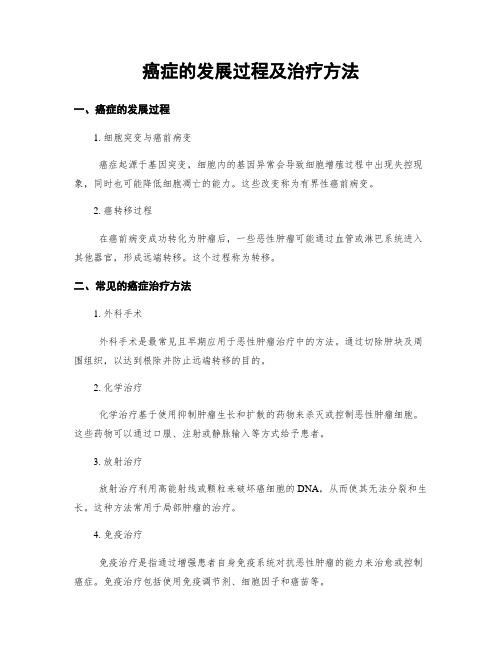
癌症的发展过程及治疗方法一、癌症的发展过程1. 细胞突变与癌前病变癌症起源于基因突变,细胞内的基因异常会导致细胞增殖过程中出现失控现象,同时也可能降低细胞凋亡的能力。
这些改变称为有界性癌前病变。
2. 癌转移过程在癌前病变成功转化为肿瘤后,一些恶性肿瘤可能通过血管或淋巴系统进入其他器官,形成远端转移。
这个过程称为转移。
二、常见的癌症治疗方法1. 外科手术外科手术是最常见且早期应用于恶性肿瘤治疗中的方法。
通过切除肿块及周围组织,以达到根除并防止远端转移的目的。
2. 化学治疗化学治疗基于使用抑制肿瘤生长和扩散的药物来杀灭或控制恶性肿瘤细胞。
这些药物可以通过口服、注射或静脉输入等方式给予患者。
3. 放射治疗放射治疗利用高能射线或颗粒来破坏癌细胞的DNA,从而使其无法分裂和生长。
这种方法常用于局部肿瘤的治疗。
4. 免疫治疗免疫治疗是指通过增强患者自身免疫系统对抗恶性肿瘤的能力来治愈或控制癌症。
免疫治疗包括使用免疫调节剂、细胞因子和癌苗等。
三、个体化癌症治疗方法的发展1. 基因检测随着基因测序技术的进步,越来越多的个体化癌症治疗方案得以实施。
通过对患者基因进行检测,医生可以了解到特定突变与特定药物的关联,从而制定更加准确的个体化治疗方案。
2. 靶向药物靶向药物是一类能够针对特异性肿瘤表面受体或信号通路进行干预和抑制的药物。
靶向药物由于其特异性和高效性,在癌症治疗中发挥着越来越重要的作用。
3. 免疫检查点抑制剂免疫检查点抑制剂可以阻断肿瘤细胞与免疫系统之间的相互作用,从而增强患者的免疫反应。
该类药物在肺癌、黑色素瘤等多种恶性肿瘤的治疗中取得了令人鼓舞的效果。
四、癌症治疗的新技术与新方向1. 基因编辑基因编辑技术如CRISPR-Cas9已经突破传统基因工程的限制,具备更高精度、更简便且更具可扩展性,有望实现对癌细胞DNA序列进行精确修饰和改变。
2. CAR-T细胞疗法CAR-T细胞(嵌合抗原受体T细胞)是一种个体化免疫细胞治疗手段。
癌症发生的原因及治疗方法

癌症发生的原因及治疗方法癌症是一类威胁人类健康的严重疾病,其发生与一系列复杂的原因相关。
了解癌症的发生原因以及治疗方法对于我们预防和治疗癌症具有重要意义。
本文将从环境因素、遗传因素、生活方式以及现代治疗方法等方面探讨癌症的原因及治疗方法。
一、环境因素与癌症发生环境因素是导致癌症发生的主要原因之一。
空气、水源和食物中存在的污染物质,如化学物质、重金属和放射性物质,都与癌症的发生密切相关。
例如,长期暴露在致癌物质如烟草烟雾、汽车尾气和工业废料中的人,患癌症的风险将大大增加。
因此,保持环境的洁净与健康对于癌症的预防至关重要。
二、遗传因素与癌症发生除了环境因素外,遗传因素也在一定程度上影响了癌症的发生。
一些人携带了与癌症相关的基因突变,这些基因突变能够增加癌症的发生风险。
例如,带有BRCA1和BRCA2基因突变的女性患乳腺癌和卵巢癌的风险明显增加。
然而,大多数癌症是由环境和遗传因素的相互作用导致的,并不仅仅是单一基因突变的结果。
三、生活方式与癌症发生生活方式在癌症的发生中起着重要作用。
吸烟、酗酒、不健康的饮食习惯以及缺乏运动等不良生活方式都会增加癌症的发病风险。
吸烟是最常见的导致多种癌症的原因之一,包括肺癌、口腔癌和食管癌等。
此外,长期暴露在紫外线下,暴饮暴食和缺乏蔬菜水果摄入也会增加癌症发病的可能性。
四、癌症的治疗方法对于癌症的治疗,目前有多种方法可供选择,具体治疗方法将根据患者的癌症类型、病情以及其他相关因素来确定。
常见的癌症治疗方法包括手术切除、放疗、化疗和靶向治疗。
手术切除是常见的治疗方法之一,特别适用于早期癌症患者。
手术可以通过切除肿瘤来治愈或缓解患者的病情。
然而,手术切除并不适用于所有的癌症类型和阶段。
放疗是利用高能射线杀灭或损伤癌细胞的方法。
通过照射肿瘤部位,放疗可破坏癌细胞的DNA结构,阻止其生长和分裂,从而达到治疗的目的。
放疗常常与手术和化疗联合使用,以提高治疗的效果。
化疗是使用药物来杀死或抑制癌细胞的方法。
防癌抗癌的正确认知

防癌抗癌的正确认知防癌抗癌一直是人们关注的重要话题。
随着科学技术的进步和医疗水平的提高,人们对于癌症的认识正在不断深化。
本文将探讨防癌抗癌的正确认知,帮助大家有效预防和应对癌症。
一、癌症的定义和分类癌症,又称恶性肿瘤,是一种细胞异常增生并扩散的疾病。
根据癌症起源和病理特点,可将癌症分为多种类型,例如乳腺癌、肺癌、结直肠癌等。
不同类型的癌症在预防和治疗上有其特殊性。
二、癌症的危害和成因癌症对人类健康产生巨大威胁。
其危害主要表现在细胞异常增生导致器官功能受损、并发症的发生以及可能引发的死亡等方面。
癌症的发生与多个因素有关,包括遗传因素、环境因素、生活方式等。
不良的生活习惯和环境污染是癌症发生的重要因素。
三、正确认识防癌抗癌1. 健康的生活方式保持健康的生活方式是防癌抗癌的基础。
这包括良好的饮食习惯、充足的睡眠、适量的运动等。
合理膳食结构,多摄入新鲜蔬菜水果和高纤维食物,减少盐、糖和脂肪的摄入,同时戒烟限酒,避免暴露于二手烟和有害物质中。
2. 充足的体力活动适当的体力活动对于预防癌症起到积极的作用。
运动可以增强身体的免疫力,提高机体抵抗癌症的能力。
每天进行适量的运动,如散步、跑步、游泳等,都能有效减少癌症的发生风险。
3. 定期体检和筛查定期体检和筛查可以及早发现潜在的肿瘤病变,有助于早期诊断和治疗。
常规的体检项目包括肿瘤标志物检测、X射线拍片、乳房、宫颈、结直肠等部位的CT、MRI等检查。
及时发现病变,有助于提高治疗效果和生存率。
4. 合理用药和治疗一些特定的药物和治疗手段可以用于预防和治疗癌症。
例如,疫苗接种可以预防宫颈癌;根除幽门螺杆菌可以预防胃癌;化学治疗、放射治疗、手术等可以用于癌症的综合治疗。
然而,使用药物和治疗方法时应遵医嘱,避免滥用。
5. 心理健康保持良好的心理状态对于健康至关重要。
学会有效应对压力,保持乐观的心态,有利于提高免疫力,减少癌症的发生。
需要时可以寻求心理咨询或支持。
四、结语防癌抗癌是一个长期而艰巨的任务。
癌症的发生机制与治疗

癌症的发生机制与治疗癌症是一种严重的疾病,它是由机体某些正常细胞发生恶性变化,形成不受控制的增殖和扩散而引起的病症。
目前,癌症在全球范围内已成为重要的公共卫生问题之一,其发病率逐年增加,死亡率也不断上升。
因此,我们需要深入了解癌症的发生机制和治疗方法,以更好地预防和治疗这种病症。
一、癌症的发生机制癌症的发生是一个复杂的过程,涉及到多种因素,包括遗传因素、环境因素和生活习惯等。
其中,遗传因素是造成癌症发生的重要原因之一。
癌症的遗传基础主要包括两类基因:肿瘤抑制基因和癌基因。
肿瘤抑制基因是一种阻止细胞生长和增殖的基因,它们对于细胞周期的控制和细胞凋亡的调节都起着至关重要的作用。
当肿瘤抑制基因发生突变或失活时,细胞的增殖和生长就会不受控制,进而形成恶性肿瘤。
相对应的,癌基因则是一类促进细胞生长和增殖的基因。
当癌基因受到突变或过度激活时,它们会促进细胞增殖并抑制细胞凋亡。
这样一来,细胞就会不断地分裂和增殖,最终形成癌瘤。
除了遗传因素外,环境因素和生活习惯也是促进癌症发生的重要原因。
环境因素包括辐射、化学物质和病毒等,这些因素都可能导致细胞基因突变和损伤。
而生活习惯则包括饮食、体育锻炼、吸烟和饮酒等,这些因素也会对癌症的发生产生影响。
二、癌症的治疗方法目前,癌症的治疗主要包括手术治疗、放射治疗和化学治疗等。
其中,手术治疗是最常见的治疗方法之一。
通过手术可以将癌瘤完全切除,从而达到治疗的效果。
对于早期癌症患者来说,手术是一种非常有效的治疗方法。
除了手术,放射治疗也是常见的治疗方法之一。
放射治疗通过向患者体内注射放射性物质,直接照射癌瘤部位,从而达到杀死肿瘤细胞的效果。
虽然放射治疗可以有效地杀死癌细胞,但是它也会对健康细胞造成一定的损伤,因此通常不是首选治疗方法。
最后,化学治疗也是一种常用的治疗方法。
化学治疗通过使用化学药物来抑制肿瘤细胞的生长和扩散,进而达到治疗的效果。
因为化学药物能够影响到整个机体,所以它通常是用于治疗广泛的癌症。
癌症的病因与治疗
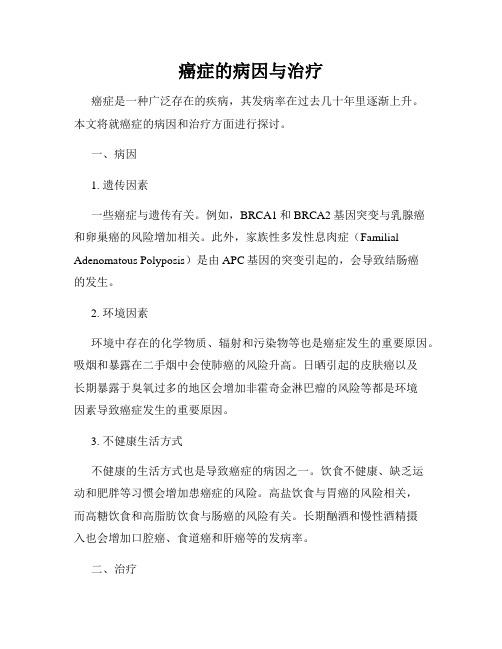
癌症的病因与治疗癌症是一种广泛存在的疾病,其发病率在过去几十年里逐渐上升。
本文将就癌症的病因和治疗方面进行探讨。
一、病因1. 遗传因素一些癌症与遗传有关。
例如,BRCA1和BRCA2基因突变与乳腺癌和卵巢癌的风险增加相关。
此外,家族性多发性息肉症(Familial Adenomatous Polyposis)是由APC基因的突变引起的,会导致结肠癌的发生。
2. 环境因素环境中存在的化学物质、辐射和污染物等也是癌症发生的重要原因。
吸烟和暴露在二手烟中会使肺癌的风险升高。
日晒引起的皮肤癌以及长期暴露于臭氧过多的地区会增加非霍奇金淋巴瘤的风险等都是环境因素导致癌症发生的重要原因。
3. 不健康生活方式不健康的生活方式也是导致癌症的病因之一。
饮食不健康、缺乏运动和肥胖等习惯会增加患癌症的风险。
高盐饮食与胃癌的风险相关,而高糖饮食和高脂肪饮食与肠癌的风险有关。
长期酗酒和慢性酒精摄入也会增加口腔癌、食道癌和肝癌等的发病率。
二、治疗1. 手术治疗手术是癌症治疗的一种主要方法。
通过手术可以切除肿瘤及其周围组织,达到治疗和控制癌症的目的。
手术治疗的方法根据不同的癌症类型和发展程度而有所不同,包括肿瘤切除术、淋巴结清扫术和整形手术等。
2. 放疗治疗放射治疗利用高能射线通过破坏癌细胞的DNA结构来杀灭癌细胞。
放疗可以用于治疗早期及晚期癌症,也可用于术前或术后辅助治疗。
然而,放疗也可能对周围正常组织造成伤害。
3. 化疗治疗化疗主要使用化学药物来杀死癌细胞或抑制其生长。
通常,化疗药物会通过静脉或口服途径给予患者。
化疗可以单独应用,也可以与手术和放疗联合使用。
然而,化疗也会导致一系列副作用,如恶心、脱发和免疫系统抑制等。
4. 靶向治疗靶向治疗是基于对癌细胞特定分子靶点的干预治疗。
这些治疗方法主要通过抑制癌细胞特定的信号通路来抑制肿瘤的生长和扩散。
靶向治疗通常用于那些含有特定基因突变的肿瘤类型,如HER2阳性的乳腺癌和EGFR突变的非小细胞肺癌。
癌症的成因与治疗方法

癌症的成因与治疗方法癌症,这个令人闻之色变的词汇,在当今社会中越来越多地出现在我们的生活中。
它就像一个隐藏在暗处的恶魔,无情地侵袭着人们的健康和生命。
那么,癌症究竟是如何形成的?又有哪些治疗方法可以与之抗衡呢?癌症的成因是一个复杂而多样化的问题,涉及到遗传、环境、生活方式等多个方面。
遗传因素在癌症的发生中起着一定的作用。
有些人天生就携带了某些基因突变,使得他们患上特定癌症的风险大大增加。
比如,家族中有乳腺癌、结肠癌等病史的人,其患病的几率可能相对较高。
但需要明确的是,遗传因素并非是癌症发生的唯一决定因素,大多数癌症并非直接由遗传导致。
环境因素也是癌症形成的重要“帮凶”。
长期暴露在有害物质中,如石棉、苯、甲醛等化学物质,以及放射性物质,都可能损伤细胞的DNA,增加患癌的风险。
此外,空气污染、水污染、土壤污染等也可能在潜移默化中影响我们的健康,诱发癌症。
生活方式与癌症的发生密切相关。
吸烟是导致多种癌症的重要危险因素,包括肺癌、膀胱癌、胃癌等。
大量饮酒可能增加肝癌、食管癌、乳腺癌等的发病几率。
不健康的饮食习惯,如过多摄入高热量、高脂肪、高糖的食物,以及缺乏蔬菜水果等富含膳食纤维和维生素的食物,容易引发肥胖、糖尿病等疾病,进而增加患癌的风险。
长期的压力、缺乏运动、睡眠不足等也会削弱免疫系统,为癌症的发生创造条件。
病毒和细菌感染也与某些癌症的发生有关。
例如,人乳头瘤病毒(HPV)感染与宫颈癌的发生密切相关;乙型肝炎病毒和丙型肝炎病毒感染可能导致肝癌;幽门螺杆菌感染则可能增加胃癌的风险。
了解了癌症的成因,接下来我们来看看目前常见的癌症治疗方法。
手术治疗是癌症治疗的重要手段之一。
对于早期发现的癌症,手术切除肿瘤往往能够取得较好的效果,有时甚至可以达到根治的目的。
但手术治疗并非适用于所有情况,比如肿瘤已经扩散或患者身体状况无法承受手术时,就需要考虑其他治疗方法。
放疗利用高能射线杀死癌细胞。
它可以单独使用,也可以与手术、化疗等结合使用。
弄清楚癌症是怎么产生的,才能战胜癌症
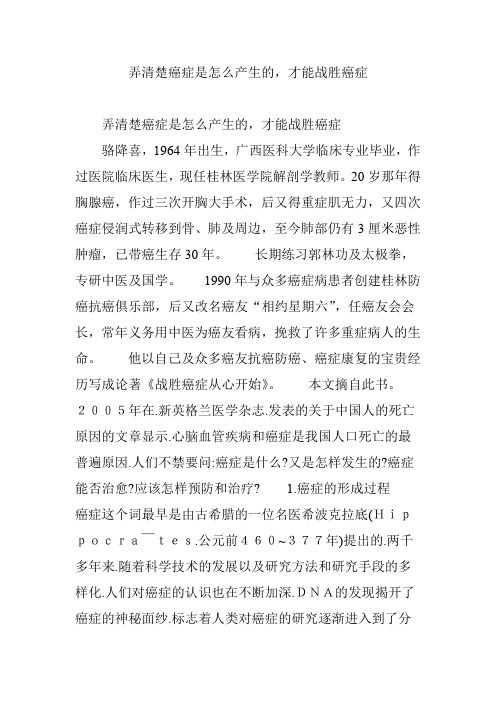
弄清楚癌症是怎么产生的,才能战胜癌症弄清楚癌症是怎么产生的,才能战胜癌症骆降喜,1964年出生,广西医科大学临床专业毕业,作过医院临床医生,现任桂林医学院解剖学教师。
20岁那年得胸腺癌,作过三次开胸大手术,后又得重症肌无力,又四次癌症侵润式转移到骨、肺及周边,至今肺部仍有3厘米恶性肿瘤,已带癌生存30年。
长期练习郭林功及太极拳,专研中医及国学。
1990年与众多癌症病患者创建桂林防癌抗癌俱乐部,后又改名癌友“相约星期六”,任癌友会会长,常年义务用中医为癌友看病,挽救了许多重症病人的生命。
他以自己及众多癌友抗癌防癌、癌症康复的宝贵经历写成论著《战胜癌症从心开始》。
本文摘自此书。
2005年在.新英格兰医学杂志.发表的关于中国人的死亡原因的文章显示.心脑血管疾病和癌症是我国人口死亡的最普遍原因.人们不禁要问:癌症是什么?又是怎样发生的?癌症能否治愈?应该怎样预防和治疗? 1.癌症的形成过程癌症这个词最早是由古希腊的一位名医希波克拉底(Hippocra ̄tes.公元前460~377年)提出的.两千多年来.随着科学技术的发展以及研究方法和研究手段的多样化.人们对癌症的认识也在不断加深.DNA的发现揭开了癌症的神秘面纱.标志着人类对癌症的研究逐渐进入到了分子水平.一项来自英国桑格研究院(WellcomeTrustSangerInstitute)的最新研究表明.癌细胞在癌症发生的过程中留下的痕迹就像留在癌细胞DNA中的考古学印记.癌细胞的突变过程在癌症引起病人注意之前很多年就已经被激活了.斯特拉顿(MikeStratton)的研究小组通过测序分析癌症患者基因组.发现了癌症发生、发展过程中出现的突变.首次解析了癌症发生发展的全过程:癌症的发生是由DNA突变引起的.癌细胞由最初正常体细胞中的DNA突变后与正常体细胞在生存竞争的过程中不断进化.最终变成永生不死的癌细胞.癌变发生的过程表明.多数癌症患者在被确诊之前.体内的癌变就已经开始.或许患者癌变早在十余年前就已经开始.如果癌症真的起源于基因突变.那我们不禁要问:导致癌症患者基因突变的根本原因是什么?实际上.人体内都有原癌基因.但绝对不是人人体内都有癌细胞.原癌基因即具有引起细胞癌变潜能的基因.在正常人体内.原癌基因的正常运行是个体发育、细胞增殖、组织再生等生命活动不可缺少的.这些基因只有发生突变时才有致癌作用.变成癌基因.原癌基因属于显性基因.等位基因中只要有一个发生突变.就会引起细胞癌变.正常细胞中虽然存在着原癌基因.但是原癌基因的活动受到严格的精密调控.其编码产物是细胞生长和分化所必需的.不会引起癌变.有趣的是.人体内还有抑癌基因.其主要作用是“管束”原癌基因.抑癌基因是隐性基因.需要两个等位基因都突变失活.才能引起细胞癌变.如果亲代传递给后代的某一抑癌基因中有一个等位基因无功能.这个后代个体就容易患癌症.在正常细胞中.原癌基因与抑癌基因协调配合.共同维持细胞的正常增殖活动.但在致癌因素作用下.原癌基因的力量会变大.而抑癌基因却变得微弱.当原癌基因产生了超出细胞活动所需要的产物时.就会引起细胞癌变.人体是由大量体细胞组成的.癌细胞则由正常的细胞衍生而来.虽然癌症起始于一个细胞突变.但是一次突变并不足以将一个健康细胞转变为癌细胞.这个突变细胞的后代必须再经过几次突变.才能形成癌细胞.也就是说.癌症的渐进发生过程非一日之寒.需要数年时间.在此期间既有内因的作用.也有外因的诱发.致癌因子需要有剂量累积效应.癌症的发生需要许多因子的共同作用.因此.致癌因素是启动癌细胞生长的“钥匙”.主要包括精神因素、遗传因素、生活方式、某些化学物质等.多把“钥匙”一起用.才能启动“癌症程序”.并且“钥匙”越多.启动机会越大.由于我们还无法破解所有“钥匙”.因此还无法攻克癌症.值得一提的是.癌细胞在转移过程中会遇到很多困难.首先要经过数十次变异.然后要克服细胞间粘附作用脱离出来.并改变形状穿过致密的结缔组织.成功逃逸后.癌细胞将通过微血管进入血液.在那里它还可能遭到白细胞的攻击.接下来癌细胞将通过微血管进入一个新器官(即“微转移”).在这里.癌细胞面临着并不友好的环境(称作“微环境”).有些癌细胞当即死亡.有些分裂数次后死亡.还有一些保持休眠状态.存活率仅为数亿分之一.存活下来的癌细胞能够再生和定植.成为化验中可发现的“肉眼可见转移”.随着转移的发展.它挤走了正常的细胞.破坏了器官的功能.最后足以使人致命. 2.怎样清除体内的癌细胞明白癌症的发病机制后.要彻底地治疗癌症.癌症患者必须深刻地反思:“自己的癌症到底是怎么得的?”如果不明白自己的癌症怎么得的.就不能从根本上治疗癌症.因为医生只能就癌症患者目前的情况进行治疗.即使医生消灭了患者身上的所有癌细胞.但如果导致癌症产生的各项因素没有消除.启动癌细胞生长的“钥匙”依然存在.那么癌症在不久的将来势必还会卷土重来.更何况目前现有的医疗手段根本无法消灭每一个癌细胞.所以抗癌不仅要合理地配合医院的治疗.更要从深层次上对自己的性格、精神因素、遗传因素、生活方式、生活环境等进行反思.从根本上斩断癌症产生的根源.有趣的是.抛开环境与遗传因素.一项关于癌症患者性格特征调查研究的结果显示.他们在性格特征上极为相似.特别是精神因素.因为许多疾病的发生和发展都与精神因素有着密切的关系.一个人如果精神过度紧张.长期处于苦闷、焦虑、恐惧、绝望等不良情绪之中.可能会引起其大脑神经和内脏器官的功能失调及细胞外环境的改变.诱发细胞突变.一项来自央视的报道显示.精神紧张忧郁与癌症有明显的因果关系.性格忧郁的妇女易患乳腺癌.科学家在诱发小鼠肿瘤的过程中发现.精神紧张的那组产生肿瘤的速度明显加快.处于冬眠状态下的动物产生肿瘤的速度很缓慢.根据对一万多名癌症病人的调查.发现大多数患者有不幸的遭遇.心理测验中抑郁评分高的人(表现为淡漠、悲观、思维与行动迟缓等)死于癌症的概率比其他人高两倍.值得一提的是.不少癌症患者知道诊断结果后.因面对癌症的恐惧以及面临死亡的巨大精神压力.癌症的转移速度大大加快.健康状况急转直下.所以要战胜癌症必须正确对待癌症、接受癌症、包容癌症.从自身剖析癌症产生的原因并采用积极乐观的态度去面对癌症.而悲观、消极和怨天尤人等态度不利于身体康复.癌症发生、发展的过程按达尔文进化论的原理来解释是.从正常的DNA突变.癌细胞克隆演化.克服压力.突破瓶颈.突变的细胞通过自然选择.克服体内层层压力.适者生存.不断演化不断克隆.直至癌症患者被确诊.这一过程需要几年甚至十余年.既然癌细胞的存活以及扩散是自然选择的结果.那么必定是在这一漫长的自然选择过程中内外因素作用于人体导致内环境改变.从而为癌细胞生存打下坚实的基础.冰冻三尺非一日之寒.所以我们有理由相信癌症只是慢性病.对癌症的治疗不能急于求成.我国著名的肝癌外科专家、中国工程院院士.被称为医学大家、肝外科界泰斗的汤钊猷院士经四十多年抗癌实践总结出.许多肿瘤人类目前无法斩尽杀绝.而且对付各种不同恶性肿瘤的方法光靠消灭不够.还要考虑改造.通过对机体的改造.改善人体的内环境.对残癌进行改造.使之改邪归正.带瘤生存.只有这样患者才能提高自身的抗癌能力.实际上.癌细胞还是向善的.癌细胞可以产生.同时也可以消除.癌细胞的表面有一种肿瘤抗原(CEA).它能生成相应的抗体阻止癌细胞生长和发展.这种自我免疫力理论上就是癌细胞消失的原因.大量的科学实验证明.人体内每个细胞的细胞膜上存在着一种叫环式磷酸腺苷(CAMP)的物质.其最显著的能力就是使癌细胞变成健康细胞.何况在体内还有免疫监控系统.可以随时消灭癌细胞.因此.癌症不是不可避免的.而是可防可治的慢性病.但是整整一个多世纪.人们认为癌症是局部病变.是区域性病变.一旦病理学证实为癌.就千方百计通过手术、放疗、化疗、局部治疗等手段去消灭它.企图在短时间内治疗癌症.癌症治疗的第一大方法是外科手术.癌症手术的范围经历了局部切除、区域性根治和扩大超根治术的过程.人们认为只要将肿瘤累及的器官和区域性淋巴结一起切除就可达到根治目的.20世纪初.放射治疗开始应用于临床.成为癌症的第二大疗法.20世纪中叶.出现了癌症的第三大疗法———化学治疗.加上之后的早期发现、早期诊断和早期治疗.以及介入疗法、局部治疗甚至器官移植等.使人类与癌症的斗争取得了有史以来最重大的进展.然而事实证明.所有这些以“消灭肿瘤”为目标的治疗手段要想把癌细胞斩尽杀绝是不可能的.甚至有可能使问题更复杂. 3.癌症只是一个慢性病著名的央视主持人罗京在2008年北京奥运会前夕的体检中被查出患有淋巴肿瘤.随后其治疗以化疗为主.罗京积极地化疗并采用造血干细胞移植方法.一个月后.罗京在身体复查时发现.其淋巴结淋巴瘤细胞消失.病情有所缓解.可3个月后罗京离世.死因是化疗引起的并发症———心脏衰竭.而本书的作者之一骆降喜老师与罗京的经历不同.他毕业于医科大学.曾经是一名外科医生.他患胸腺癌并发重症肌无力.由于他学会了如何“与癌共舞”.30年来与肿瘤和平相处.现在作为一名人体解剖学教师的他不仅生存质量很好.而且还成为桂林抗癌组织中的一位义务工作者.用自己的亲身经历帮助其他癌症患者康复.所以对于癌症患者来说.与其消灭癌症.不如控制癌症.把癌症当作一种慢性病来治疗.上海中医药大学何裕民教授指出.癌症不过是一种与冠心病、高血压一样的慢性疾病.只是比较棘手.治疗有一定难度.但绝非不治之症.甚至癌症有时还比冠心病、糖尿病等要好治得多.不少癌症患者5年以后病情可完全稳定.甚至治愈.不再需要定期用药.而冠心病、糖尿病、高血压等疾病的患者只能终身服药.有海外尸检报告显示.80岁以上老年人出现恶性肿瘤的概率很大.有1/4的老年人身患癌症.却无任何不适.后却死于其他因素.黄又彭博士早年毕业于瑞士日内瓦大学医学院.现为解放军305医院抗衰老临床中心顾问.瑞士联邦医学科学院临床免疫学学会会员.欧洲共同体免疫学会会员.有着30多年从事免疫学与肿瘤研究的经验.他以其自身曾长期从事尸检的经历认定.如果对80岁左右病故的老人都做一遍尸解.会发现100%的人体内都会有肿瘤.本书作者之一骆降喜老师从事人体解剖学教学多年.在其解剖的老年人中.多数都具有肿瘤.但是他们均属自然死亡.所以肿瘤的发生是生物进化当中一个正常的过程.每个人的体内都有可能产生肿瘤.肿瘤细胞生长很慢.是一个慢性的消耗过程.肿瘤不会在几天、几个月甚至几年之内就把人杀死.更不会像心脑血管病那样会导致患者突然死亡.大部分肿瘤患者是被吓死的.因为它使人恐惧、悲哀、抑郁、免疫系统崩溃、内分泌失调.本书出版的目的是通过两位30年以上“老癌”的亲身经历.让人对肿瘤有一个客观的认识.目前世界范围内对肿瘤治疗始终存在一个误区:注重肿瘤本身.想尽办法去杀死它.人们利用手术、放化疗技术杀死肿瘤.结果化疗后不仅癌细胞产生耐药性.残癌的恶性程度(侵袭和转移的能力)也可能增强.当前的分子靶向治疗剂.同样也会导致未被消灭的残癌的侵袭和转移能力增强.大剂量的放化疗在杀死癌细胞的同时.也杀伤正常的细胞.破坏人体的自稳态.导致人与癌细胞同归于尽.近年来国际顶尖杂志.自然.陆续刊登了一些文章.指出目前主要的分子靶向治疗剂、抗血管生成剂.虽能抑制肿瘤生长.却也能促进癌转移. 4.人体对癌症的自我调节能力事实上.人体拥有一套完整的自稳调节控制机制.即自稳态.自稳态.也称内环境稳定(homeostasis).是指正常机体主要在神经和体液的调节下.在不断变动的内外环境因素作用下能够维持各器官系统机能和代谢的正常运行.维持内环境相对的动态稳定性.正常机体的血压.心率.体温.代谢强度.腺体分泌.神经系统和免疫功能以及内环境中各种有机物质和无机盐类的浓度、体液的pH等.往往有赖于神经和体液互相拮抗而又互相协调的自稳调节的影响.从而被控制在一个狭隘的正常波动范围内.这是整个机体的正常生命活动所必不可少的.在各种自稳调节的控制下.正常机体各器官系统的机能和代谢活动互相依赖.互相制约.体现了极为完善的协调关系.细胞的自稳调节与内环境有关.细胞外液(包括血浆、淋巴、脑脊液及一切组织间液)是高等动物机体的内环境.也就是细胞直接生活的环境.内稳态的保持涉及全身每一器官、组织和细胞活动的调节.表现在生物系统的各级水平上.从细胞到整体.当内外环境因素的改变使内环境改变.从而导致某一器官系统的一个部分受到损害而发生机能代谢紊乱、自稳态不能维持时.就有可能通过连锁反应而引起本器官系统其他部分或者其他器官系统机能代谢的变化.新陈代谢的紊乱会引发DNA的变异.新产生的癌细胞在适宜的内环境中通过竞争占据优势从而为其扩散打下基础.既然癌细胞能在适宜的内环境的生存竞争中占据优势.那么也可以在其不利的内环境中被人体免疫细胞清除.机体可以通过神经—内分泌—免疫机制来调节内稳态.因为人体的神经系统、内分泌系统和免疫系统也是一个有机的统一体.机体通过人体神经系统的调节作用.释放有益的神经递质.改善人体的内分泌.不断增强人体的免疫力.从而改善人体内环境.人体内环境的不断改善使癌细胞的生存空间不断地缩小.最终使癌组织也不断缩小.癌症的康复过程类似于生态平衡.生态系统失衡后重新建立原有的平衡不是短时间内能够完成的.它是一个长期的过程.因此内稳态平衡的重建也需要足够的时间.不能急于求成.癌症只是慢性病.慢性病的治疗目标是尽可能减少疾病对患者生活与生存带来的不利影响.控制或减缓该病的发展或恶化态势.帮助患者活得更好.活得更长.在临床实践中.失去精神支柱的癌症患者是很难获得理想疗效的.西方医学奠基人希波克拉底认为.医师所应医治的不仅是病.而且是病人.他主张在治疗上注意病人的个性特征、环境因素和生活方式对患病的影响.但是在科学技术的推动下.20世纪的人类忘乎所以.认为自身无所不能.面对肿瘤患者.不少大夫只是治疗癌症.并不关心癌症病人本身.采用大剂量的放化疗以及过量的中药治疗.企图在最短时间内将癌细胞歼灭.最终导致人与癌同归于尽.本书通过抗癌明星“癌政委”对话骆老师的方式.用他们带癌生存的亲身经历.以及20多年来义务在抗癌组织“桂林市相约星期六”推广抗癌经验取得的成功经验(目前抗癌协会中5年以上存活率和10年以上的存活率远高于我国乃至世界的平均水平).为广大的癌症患者树立了榜样和示范.他们帮助患者打破对死亡的恐惧.为患者带来了生的希望.通过对该抗癌组织10年以上抗癌明星的经历进行采访、分析、对比和总结.作者发现尽管他们患病的种类不同.接受的治疗不同.但是他们之间有不少显著的共同点:首先.他们善待癌症.和谐生命.他们接受现实但不悲观.也不急于消灭癌细胞.而且把癌细胞当成是自己身体的一部分.其次.他们通过靠规律、靠自己、靠大家的方式客观地认识自己所患的疾病及患病的主要原因.弄清楚自己应该接受哪种方式、哪种强度的治疗.他们不迷信所谓的权威医院、最高级的设备、最好的化疗药物.他们也不会盲目地尝试民间流传的所谓偏方秘方.他们善于学习、勤于交流.能够认真地检视自己的饮食习惯和生活方式.对其中不正确的部分果断地加以改正.他们不但会采取各种合理有效的方法宣泄自己的不良情绪.还会自发地组织起来.利用群体的力量与疾病抗争.把癌症的康复经验义务向社会推广.他们通过自我磨练、自我修正、自我提高.不仅把自己的生命从死神手里夺回来.而且通过豁达的人生观和价值观深刻理解和正确诠释生命的意义.他们在抗癌的过程中走出了一条人性关爱、人文关爱与生命关爱的癌症康复文化之路.最终实现本性康复———文化康复———社会康复———心理康复———身体康复.骆降喜与41年癌龄的周淑君合影骆降喜义诊。
癌症是什么综述

癌症是什么综述癌症是一类严重的疾病,它由于细胞内的DNA损伤而引发肿瘤的恶性增长。
它是全球范围内引发死亡的主要原因之一。
根据世界卫生组织的数据,每年约有900万人死于癌症,其中包括各类癌症如肺癌、乳腺癌、结肠癌和前列腺癌等等。
本文将对癌症的定义、发病机制、预防和治疗等方面进行全面的综述。
首先,癌症是由体内细胞发生恶性变化导致的一类疾病。
正常情况下,细胞会按照一定的规律进行分裂和生长,但当DNA受到损伤时,细胞的分裂和生长过程可能会受到干扰。
这些受损细胞可能会无法自行修复,继续不受控制地分裂,形成肿瘤。
癌症可以分为良性和恶性两种类型。
良性肿瘤通常不具有侵袭性,不会扩散到周围组织;而恶性肿瘤具有侵袭性,可以扩散到周围组织,并通过血液和淋巴进一步转移到其他部位。
其次,癌症的发病机制非常复杂,涉及多个遗传和环境因素的相互作用。
遗传突变、环境暴露以及生活方式等都可能对癌症的发病起到重要作用。
例如,某些基因突变可以增加个体患某种特定癌症的风险,而暴露在致癌物质中也会增加癌症的发生率。
吸烟、饮酒、不健康饮食和缺乏体力活动等不良生活习惯也与癌症的风险增加相关。
要预防癌症,人们可以采取许多措施。
首先,注意生活方式的健康。
保持健康的饮食习惯,摄取丰富的水果、蔬菜和全谷物,减少红肉和加工肉类的摄入,限制高盐、高糖和高脂肪食物的摄入。
同时,要保持适度的运动量,控制体重,戒烟限酒。
其次,避免接触致癌物质。
注意环境卫生,避免暴露在放射线、化学物质和其他致癌物质中。
最后,接受合理的筛查和早期发现。
针对不同类型的癌症,存在不同的筛查方法,如乳腺癌的乳腺X线检查和结直肠癌的结肠镜检查等。
早期发现癌症有助于提高治疗的成功率和生存率。
治疗癌症的方法也多种多样,包括手术切除、放射疗法、化疗、靶向治疗和免疫治疗等。
手术切除是最常见的治疗方法,通过手术将癌症组织彻底切除。
放射疗法使用高能辐射杀死癌细胞,而化疗则是使用化学药物杀死癌细胞。
靶向治疗则是利用特定的药物针对癌症细胞中的特定分子进行干预。
- 1、下载文档前请自行甄别文档内容的完整性,平台不提供额外的编辑、内容补充、找答案等附加服务。
- 2、"仅部分预览"的文档,不可在线预览部分如存在完整性等问题,可反馈申请退款(可完整预览的文档不适用该条件!)。
- 3、如文档侵犯您的权益,请联系客服反馈,我们会尽快为您处理(人工客服工作时间:9:00-18:30)。
Physicists' model proposes evolutionary role for cancerStressed cells could become cancerous as a 'safe mode', pointing to oxygen and immunotherapy are the best ways to beat the disease.•Zeeya Merali02 October 2014Article toolsRights & PermissionsAn article by Scientific American.US National Cancer InstituteCould cancer be our cells’ way of running in ‘safe mode’, like a damaged computer operating system try ing to preserve itself, when faced with an external threat? That’s the conclusion reached by cosmologist Paul Davies at Arizona State University in Tempe and his colleagues, who have devised a controversial new theory for cancer’s origins, based on its evolutionary roots. If correct, their model suggests that a number of alternative therapies, including treatment with oxygen and infection with viral or bacterial agents, could be particularly effective.At first glance, Davies, who is trained in physics rather than biomedical science, seems an unlikely soldier in the ‘war on cancer’. But about seven years ago he wasinvited to set up a new institute at Arizona State — one of 12 funded by the US National Cancer Institute — to bring together physical scientists and oncologists to find a new perspective on the disease. “We were asked to rethink cancer from the bottom up,” Davies says.Davies teamed up with Charley Lineweaver, an astrobiologist at The Australian National University in Canberra, and Mark Vincent, an oncologist at the London Health Sciences Center in Ontario. Together they have come up with an ‘atavistic’ model positing cancer is the re-expression of an ancient “preprogrammed” trait that has been lying dormant. In a new paper, which appeared in BioEssays in September1, they argue that because cancer appears in many animals and plants, as well as humans, then it must have evolved hundreds of millions of years ago when we shared a common single-celled ancestor.At that time, cells benefited from immortality, or the ability to proliferate unchecked, as cancer does. When complex multicellular organisms developed, however, “immortality was outsourced to the eggs and sperm,” Davies says, and somatic cells (those not involved in reproduction) no longer needed this function.The team’s hypothesis is that when faced with an environmental threat to the health of a cell — radiation, say, or a lifestyle factor —cells can revert to a “preprogrammed safe mode”. In so doing, the cells jettison higher functionality and s witch their dormant ability to proliferate back on in a misguided attempt to survive. “Cancer is a fail-safe,” Davies remarks. “Once the subroutine is triggered, it implements its program ruthlessly.”Speaking at a medical engineering conference held at Imperial College London, on 11 September, Davies outlined a set of therapies for cancer based on this atavistic model. Rather than simply attacking cancer’s ability to reproduce, or “cancer’s strength,” as Davies terms it, the model exposes “cancer’s Achilles’ heel.” For instance, if the theory is correct, then cancer evolved at a time when Earth’s environment was more acidic and contained less oxygen. So the team predicts that treating patients with high levels of oxygen and reducing sugar in their diet, to lower acidity, will strain the cancer and cause tumors to shrink.The effects of oxygen level on cancer have been independently investigated for many years and appear to support Davies’s ideas2, 3, says Costantino Balestra, a physiologist at Paul Henri Spaak School and the Free University of Brussels, both in Belgium. In unpublished work that has been submitted for peer review, for instance, Balestra and his colleagues have recently demonstrated that slightly elevated oxygen levels can begin to induce leukemia cell death without harming healthy cells.“It almost looks too easy,” Balestra says. “Our preliminary results seem to show that supplying a little extra oxygen for one or two hours a day, in combination with other traditional cancer therapies, would benefit patients without any harsh side effects.”Balestra emphasizes, however, that thi s work was not carried out to test Davies’s hypothesis and cannot be taken as proof that the atavistic model is correct.Davies and his colleagues also advocate immunotherapy — specifically, selectively infecting patients with bacterial or viral agents. Medical researchers are already investigating the promising effects of such an approach for artificially boosting patients’ immune systems to aid in their recovery. Immunotherapy has already performed well in treating melanomas, for instance, and its effects on other cancers are being studied. According to the atavistic model, however, in addition to invigorating the immune system, cancer cells should also be more vulnerable than healthy cells to being killed by infectious agents because they lose higher protective functionality when they “reboot into safe mode,” Davies says. Recent studies injecting clostridium spores in rats, dogs and a human patient also appear to support this interpretation, he says.Some scientists, such as David Gorski, a surgical oncologist at Wayne State University in Detroit, Michigan, remain skeptical. “The ‘predictions’ of atavism are nothing that scientists haven’t come to by other paths,” he says.Davies and his colleagues have already begun a more direct test of their theory, ina nswer to such criticisms. “The key to our theory is looking at the ages of the genes responsible for cancer,” Davies explains. The atavistic model claims that with the onset of cancer, cells revert to a more primitive mode and more recently evolved functions are switched off. The team therefore predicts that as cancer progresses, more recently evolved genes should lose function, whereas ancient genes become active.To check if this hypothesis is correct, Davies and his colleagues are currentlycross-referencing data from the cancer genome atlas, which identifies the genes that are involved in cancer, with various databases that classify the genes that we have in common with other species. The latter data set enabl es biologists to trace back genes’ ages. Any correlation that exists between the gene age and cancer will be a boost to the atavistic model. “Combining the two data sets hasn’t been done before,” Davies says. “But it’s essentially a data-mining exercise th at doesn’t take much money and it’s something we’re working on now.”Brendon Coventry, a surgical oncologist and immunotherapist at the University of Adelaide in Australia, sees value in physicists working with oncologists to piece together existing medica l evidence to try to understand cancer’s origins. “Enormous amounts of money and the brightest minds in biological and medical science have failed to make a big impact in the war on cancer, so maybe it’s time for a new paradigm,” Coventry says, adding: “A cosmologist can look at the cell as an ‘internal universe’ to be explored in a new way.”Nature:癌症或为细胞进入“安全模式”?癌症是人体细胞试运转“安全模式”所产生的吗,就像受损计算机系统在面临外部威胁时试着保护自己那样?这是美国亚利桑那州立大学宇宙学家Paul Davies和同事得出的结论,他们提出了一个备受争议的癌症起源新理论。
